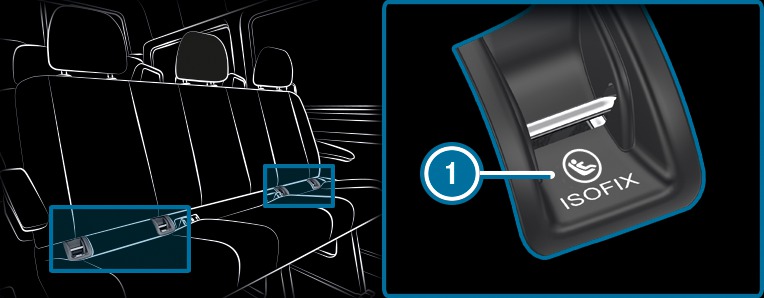Too much load may be placed on the ISOFIX child restraint system and the child may not be restrained correctly in the event of an accident, for example.
in the manufacturer's installation and operating instructions for the child restraint system used
on a label on the child restraint system, if available
Check regularly that the permissible gross mass of the child plus the child restraint system is not exceeded.
 Always observe the correct use and suitability of the seats for attaching a child restraint system. ISOFIX child seat anchor
Always observe the correct use and suitability of the seats for attaching a child restraint system. ISOFIX child seat anchor  Always observe the manufacturer's installation and operating instructions for the child restraint system used.
Always observe the manufacturer's installation and operating instructions for the child restraint system used.  Make sure that the child's feet do not touch the front seat. If necessary, move the front seat slightly forwards.
Make sure that the child's feet do not touch the front seat. If necessary, move the front seat slightly forwards.
 When fitting an ISOFIX child restraint system, also observe the following:
When fitting an ISOFIX child restraint system, also observe the following:  When using a Group 0/0+ baby car seat and a Group 1 rearward-facing child restraint system on a rear seat: adjust the rear and/or front seat so that the front seat does not touch the child restraint system.
When using a Group 0/0+ baby car seat and a Group 1 rearward-facing child restraint system on a rear seat: adjust the rear and/or front seat so that the front seat does not touch the child restraint system.  When using a Group 1 forward-facing child restraint system: the backrest of the child restraint system must, as far as possible, lie flat against the backrest of the seat.
When using a Group 1 forward-facing child restraint system: the backrest of the child restraint system must, as far as possible, lie flat against the backrest of the seat.  For certain child restraint systems in weight group 2 or 3, there may be restrictions on the maximum size setting, e.g. due to possible contact with the roof.
For certain child restraint systems in weight group 2 or 3, there may be restrictions on the maximum size setting, e.g. due to possible contact with the roof.  Do not put the child restraint system under strain between the roof and the sitting surface and/or fit it facing the wrong direction.
Do not put the child restraint system under strain between the roof and the sitting surface and/or fit it facing the wrong direction.  Do not put the child restraint system under strain by the head restraint. Adjust the head restraints as appropriate.
Do not put the child restraint system under strain by the head restraint. Adjust the head restraints as appropriate.


Before every journey, make sure that the ISOFIX child restraint system is engaged correctly in both mounting brackets in the vehicle.
 in the vehicle.
in the vehicle. 
